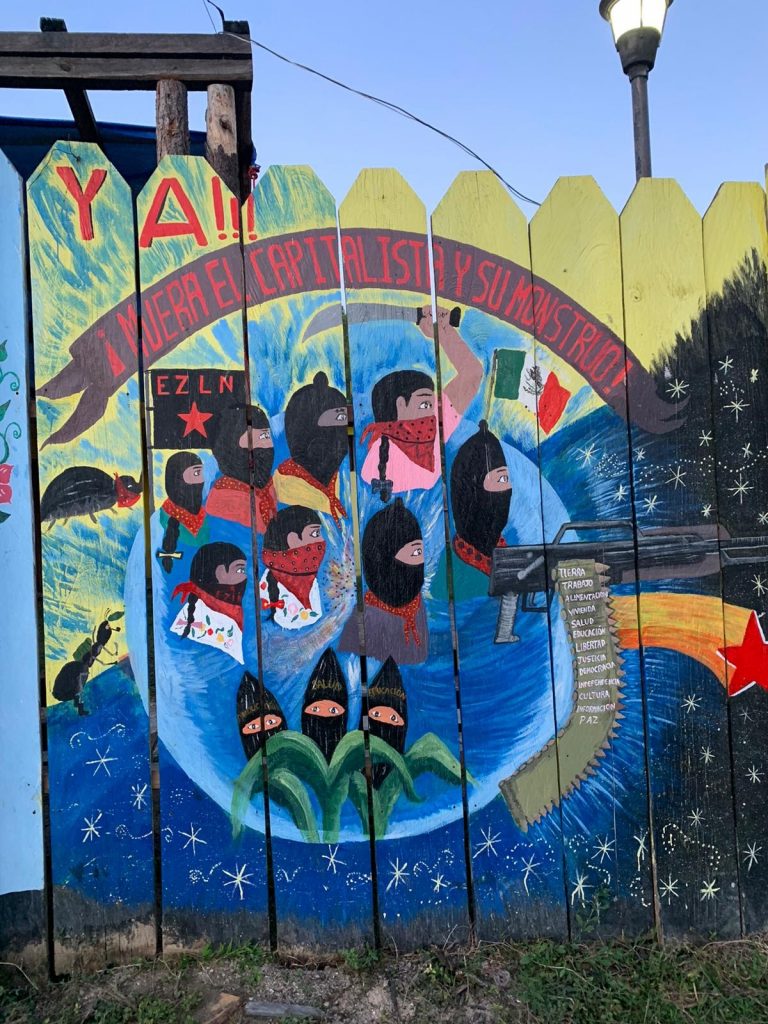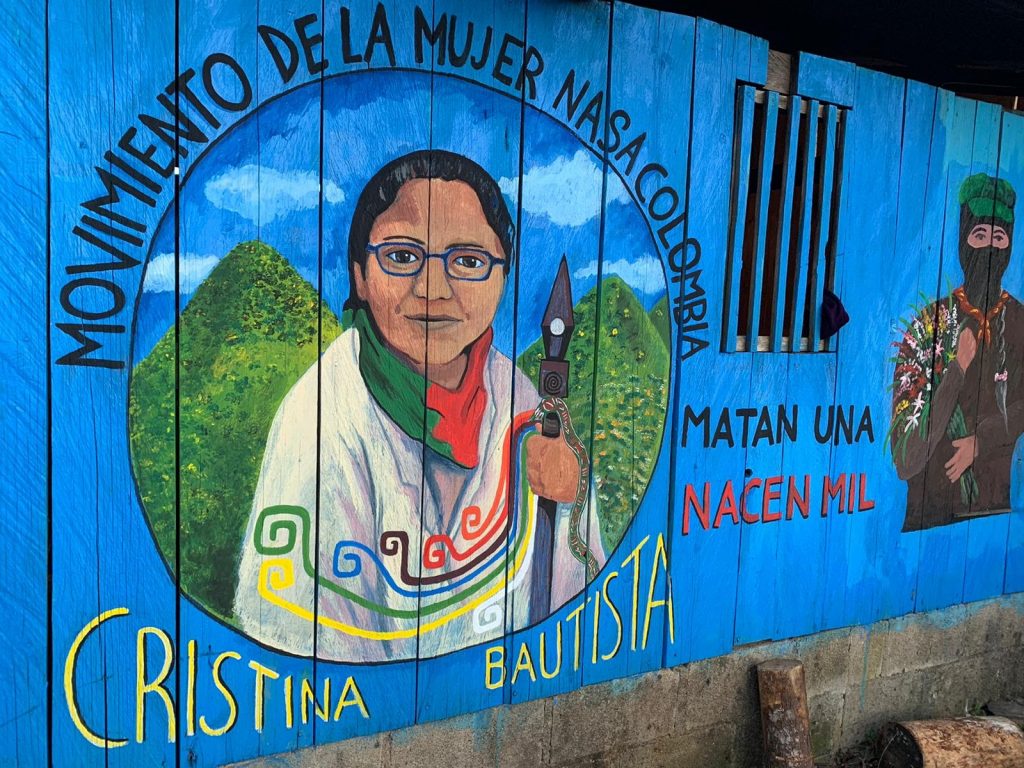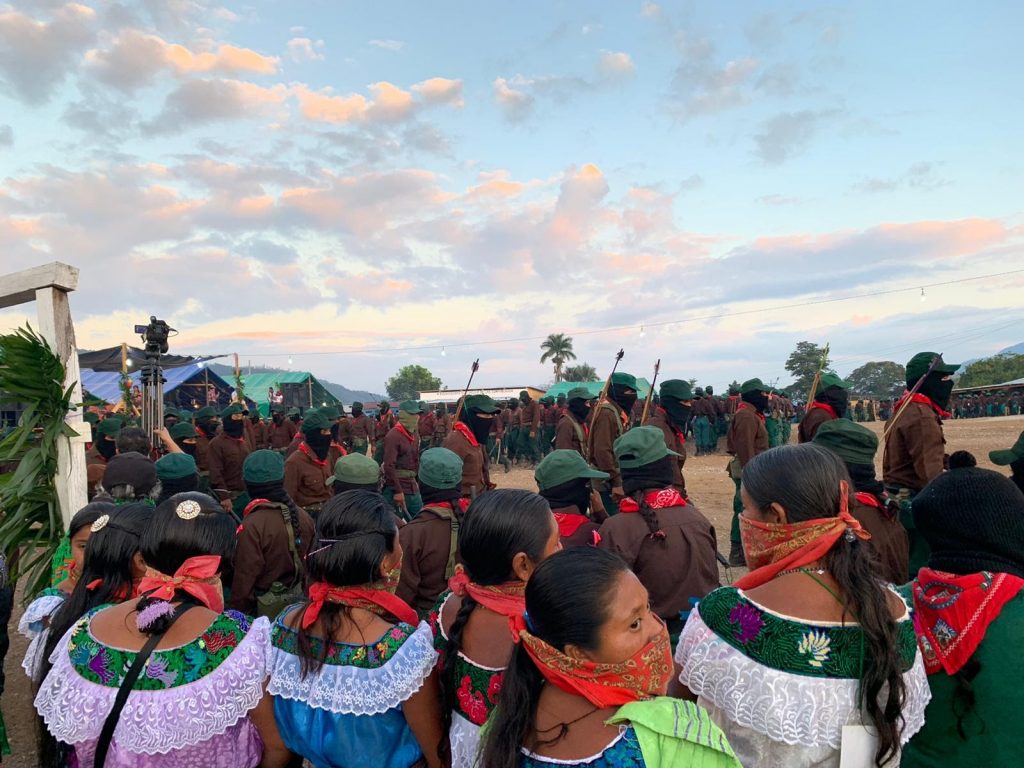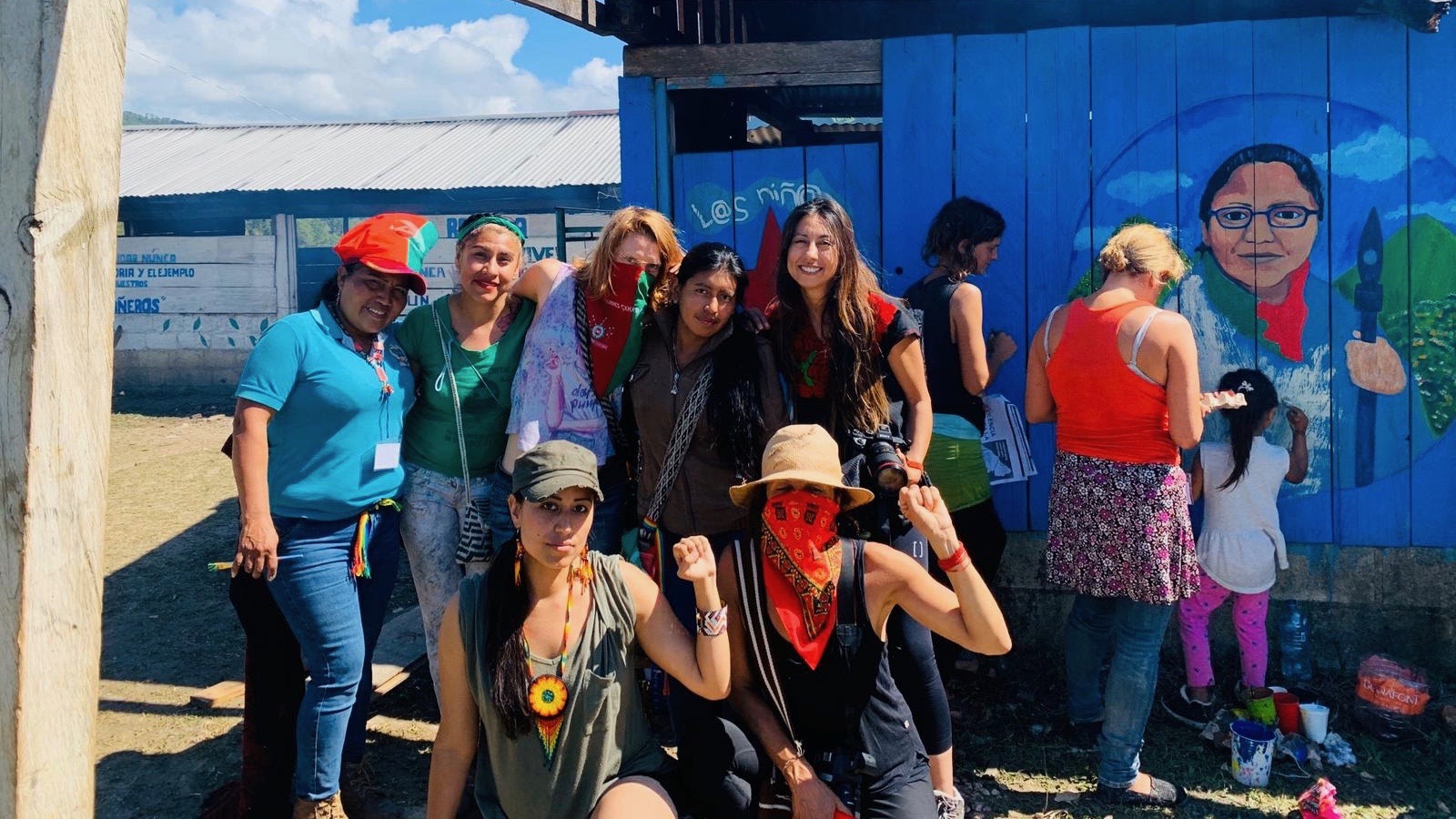At the inauguration of the International Gathering of Women Who Struggle, the women members of the Zapatista National Liberation Army welcomed the arrival of thousands of sisters from around the world with a performance in formation, bows and arrows at their sides, on liberated sacred land in Chiapas, Mexico. The attendees traveled from 49 countries — in collectives or movements, as individuals, with their children, in a caravan of buses — to participate in the Encuentro de mujeres from December 26-29, 2019.
The Zapatistas, an autonomous Indigenous movement of armed people that launched their uprising against the Mexican government on January 1, 1994, have held numerous gatherings with global attendance, but the Encuentro de mujeres is a new phenomenon. The second-ever Encuentro de mujeres was convened to visibilize and denounce violence against women in a space comprised and supported entirely by women — Zapatista men and others are not permitted past a certain check point, but rather stand by in solidarity on the caracol’s perimeters.
Held in one of the Zapatista’s largest autonomous communities, Caracol Morelia, the Encuentro brought together women from a wide range of perspectives to share the stories of their diverse struggles against patriarchy and capitalism. Hosted by Indigenous women, the Encuentro itself is an act of decolonization, centered around bringing women together to imagine and build on their visions of justice and autonomy in their various communities.
Daisy Bugarin, a member of Semillas Collective and an adherente of La Sexta Grietas Del Norte, a US-based Zapatista solidarity network, says the Encuentro was an organic, communal space for exchange — more than it was a presentation by the Zapatistas, it was about collectively healing from the global crises of femicide, systemic violence and abuse of women, by listening deeply to others. “When you see it, you see that it’s real, it’s autonomy and revolution — a body of women that’s marching together.”
After a report back from members of Semillas Collective, Julia Thomas sat down with Daisy Bugarin to talk about the journey to the Encuentro, the organization and flow of the days-long gathering, Semillas Collective’s organizing to support the attendance of Indigenous Colombian women and how the principles of Zapatismo can be applied in other geographies.

Julia Thomas: Let’s start with your journey this year to the Encuentro, the second annual gathering of women. You traveled by caravan from Mexico City. Could you talk a little bit about what that was like and the process of getting to Chiapas?
Daisy Bulgarin: The journey to the Encuentro is always a huge part of the experience. Encuentro itself means to meet up or to gather. When we do it in caravans with many women coming from all over, as soon as you get to the meeting point in Mexico City, there’s a long line of women of all ages from all over.
Thanks to our sisters from Mujeres y La Sexta We ended up filling seven charter buses. From the very beginning of it all, there was so much energy because you realize how many people made it a point to come here in the middle of December, the day before Christmas.
The reason why we tend to go in caravans is because of our safety. We all understand that by going together collectively, many of us are going to be safer rather than traveling alone. The total duration of our trip to Chiapas was 24 hours. That gave us an opportunity to get to know each other and really share.
That’s where I feel like the Encuentro really begins. You could already feel that it’s a safe space, that we’re here to take care of each other. We’re here to help each other. And that just kind of continued as we got closer and closer to Chiapas. Those stories that you didn’t even really hear at the Encuentro, you heard on the bus, while we were in movement with elders and organizers who had been with the Zapatista women since the beginning. That was really enriching for all of us that went from the US and sisters who were from afar as well.
JT: Something that came up at the Semillas Collective report back is that at the first ever Encuentro there was a lot of sadness surrounding the bloodshed and massacres that had taken place around the time of the Zapatista uprising that began on January 1, 1994. The 2019 Encuentro was a weekend full of women sharing testimony, denouncing their abusers and harassment, but it was also full of energy and empowerment. Could you speak a little bit about that?
DB: Around the time when the uprising happened, when the Zapatistas had just declared their autonomy, a lot of blood had been shed and people had been killed. There had been rape, violence, and they were crying for loved ones who literally hung from trees.
At the first last official gathering, which was just a few years ago, we still heard a lot of stories. It was again the Zapatistas presenting, giving presentations, giving performances through art, talking about what their life was through war and becoming autonomous and rising up against the government. This last one was different because they created a safe space, they gave the mic and a platform to listen to us. It wasn’t them presenting so much. They did at the end with art. They played music again for the anniversary celebration, but the actual women’s gathering wasn’t them anymore.
A lot of women and elders who were there were pointing out to us, “We’re the same women who cried and who gave our testimony and we’re now sitting in chairs listening to other women cry and give their testimonies about what’s going on in their territories all over the world.” I think when they invited everyone to share, even the Zapatista women didn’t imagine how many people were going to share their story and how many stories needed to be shared. It took us going all the way to a caracol in Chiapas to feel safe to tell our story, to denounce our abusers and to denounce patriarchy.
It shouldn’t be that way.
It was supposed to be a one day thing, and it just continued and continued and continued to the very end of the Encuentro. There was an agenda and workshops and everything planned throughout the weekend so that we could meet and organize ourselves but they never said okay, that’s enough. I thought that was really special and it made us think like, “Do we do that here enough? Are we creating a safe space? How do we create a safe space and listen to each other? I think that’s part of denouncing the abuser and also healing.
JT: Could you speak about the structure of the Encuentro and what it looked like from the opening ceremony?
DB: We got to watch the opening ceremony sitting with Marichuy the Indigenous Peoples Congress “vocera” spokesperson which made it extra memorable and special.
The organization of everything was really impressive. The Zapatista men who I talked to outside the caracol organized with themselves. The younger sisters, the youth especially — they call them la milicianas — really took leadership and took initiative. They did all the labor, everything from logistics to registration to actually driving us in.
You get to see teamwork, a level of great communication and how they helped each other, and what it looks like to work as a whole, a collective, as many, not just as one. You saw that organization throughout the weekend. In the mornings they would get up early to do all the prep. At night, there was the cleaning up, the transportation of water. A lot of physical labor that was really intense and heavy, they did it all. It was intended to show what a world with just women would look like, that they didn’t have to depend on men.
JT: There was conversation and engagement at the intersections of lots of different struggles with women who came from across the world. What were your observations, looking at the dynamics of those interactions throughout the Encuentro?
DB: Some of the beautiful things that I noticed were the connections between women of color from all over, who were going through essentially the same struggle for life because of patriarchy — disappearances or violence throughout Latin America, for example. There was also a lot of sewing of connections and networking, specifically among Indigenous women. Seeing messages from women from Palestine and women from Kashmir or India, women who are resisting imperialism and capitalism and defending their territory.
Defense of territory was obviously a theme that connected through everything else, and patriarchy, and how it targets women’s bodies.
JT: What approach did your organization, Semillas, take to attending the Encuentro?
DB: What we did was launch a fundraiser, but not for us, for Cristina Bautista who was killed not long ago. She was part of the Indigenous group Guardia de Cauca in Colombia and her dream was to go to the Encuentro de Mujeres. She was an Indigenous authority and guard for her community and was a very outspoken human rights, environmental and feminist leader, which is why she was killed. Before being murdered she started a feminist collective called “Mujer Nasa Hilando Pensamiento. Her sisters, her friends and her collective wanted to go, but they didn’t have the funds. The money that they had was used for her funeral and we just couldn’t stand it. We teamed up with Protect the Sacred NYC to launch a fundraising campaign and a matter of two and half weeks raised enough money for 4 of them to attend the gathering, including two of the youngest members of the community.
This was really special for Semillas because we saw the power again of women working together, of us women working with them as women. It was magic, the fact that our comrades from Cauca went and got to meet everyone and make so many connections.
At the Encuentro, the idea of a mural was proposed to the Zapatista women and they gave us this wall right next to the Comedor de Las Milicianas, not far from the mural of the Comandanta Ramona, a very special leader. The process was very collaborative and collective. Artists from Chile, from Ecuador and Mexico — in one day, they found paint and they just started doing it the last day we were there. The Encuentro made this kind of thing happen. It also made us organize ourselves. We’re collective women and we help each other out, support each other. We sow solidarity.

JT: What was the opening ceremony like?
DB: It’s always really impressive when you see a massive group of all women, mostly young women, on the horizon marching and you see the dust and their bows and arrows. Theres this idea that Zapatismo is something from the past, or just an idea, a theory or unattainable dream. When you see it, you see that it’s real, it’s autonomy and revolution — a body of women that’s marching together. Yes, in a military kind of way, but not representing the government and not representing the kind of military that is killing or causing war, protecting capitalism, but doing the opposite: protecting Mother Earth, fighting against capitalism, fighting against patriarchy.
When you see those women, you feel something that you’ll never get from a military formation that represents any capitalist government. They’re real people, you can feel their energy and you can hear them laughing or smiling or talking or serious and it just makes it so much more real and gives you a lot of hope, a lot of hope, because all of a sudden, it’s so tangible for everyone.
JT: How did the Zapatistas present the state of Zapatismo?
DB: That was brought up a lot. The last day of the Encuentro, they started to talk about the defense of territory. They said, “We’re going to keep defending Mother Earth because capitalism obviously is not working, not working anywhere, it’s connected to all these other things that are happening in the world that support the patriarchy. So we’re going to continue to fight. And as you all can see, adopting these principles, we’re growing our autonomy because we’re getting bigger, we’re starting caracoles.”
Even though fascists are taking over all over the world, the Zapatistas have managed not to get smaller or to get scared. They’re growing.

The report backs have been really important in different cities and different spaces, taking with us the importance of having more gatherings, more encuentros, in our own geographies, asking, “How do we grow autonomy, how do we organize something similar to a Zapatista autonomous clinic, how do we get medicine or services? How do we put our heads together to figure that out?”
We are coming up with creative solutions, being more creative than the oppressor. The Zapatistas teach us that. We see how they transform the land. Whether it is a basketball court or a yard or a small room, they can transform it into a clinic, they can transform it into a kitchen, they can transform it into a classroom, and they do.
It’s constantly making the most use of what we have and sharing knowledge. I think that everyone brings home their own ideas about this and it’s going to look extremely different in Mexico City, Oaxaca or Jalisco or Palestine or Canada. Once you’re working for a collective goal or for the life of Mother Earth, it doesn’t have to be that complicated. But it does take serious reflection on our relationship with money and capitalism, going beyond just reading the Zapatista books and visiting and going to the Encuentro and thinking it’s cool but actually applying their principles in our daily life.. If you have enough people power — that’s what they teach us — if we’re applying these principles and there’s enough of us, we can absolutely do it. We must ask ourselves “How do we continue to show up?”
JT: To people here in New York, are there things that you think are misunderstood about Zapatismo or that you’re hoping to disseminate?
DB: It’s always very inspiring to see the respect and love there is for Zapatistas and Zapatismo. What Semillas and a lot of us are committed to is thinking about how we can be strategic and be allies and also learn to implement Zapatismo in our geographies in the US.
A way of showing respect to the EZLN is to stay updated with their struggle against megaprojects in Mexico, indigenous leaders continue to be killed for protecting mother earth and the autonomy of their communities, we must also realize that. The revolution obviously begins in your own backyard, even in your health, your body, you as an individual and how you relate to those around you, looking at the bottom, at those who are the most oppressed wherever you are, recognizing whatever privilege you have. To keep Zapatismo alive and to keep autonomy alive it takes everyone to help plant that seed and harvest it and water it.





